Abstract
The paper presents the results of modeling the problem of injecting liquid sulfur dioxide into a porous reservoir initially saturated with methane and ice. The model presented in the paper assumes the formation of three different regions, namely the near one, saturated with liquid SO2 and its hydrate; the far one, containing methane and ice; and the intermediate one, saturated with methane and water. The effects of various parameters of the porous medium and injected SO2 on the nature of the course of the hydrate formation process have been studied. It is shown that with a decrease in reservoir permeability or injection pressure, the length of the intermediate region decreases, which, in the limiting case, means the formation of SO2 hydrate in the mode without the formation of an extended region saturated with methane and water. It is shown that such a regime is also typical for the case of high initial injection pressures, as well as low values of the initial reservoir temperature and injection temperature.
MSC:
76-10; 35Q79
1. Introduction
Gas hydrates or clathrates are crystalline compounds formed under certain thermobaric conditions and containing gas and water in their composition. Under certain thermobaric conditions, gas hydrates are formed mainly from gas and water (or ice) [1,2]. Since the 1960s, the emphasis in the study of gas hydrates began to shift toward the extraction of gas from their composition. At that time, the Messoyakh gas hydrate field, deposits in the Mackenzie Delta, and natural accumulations of hydrates at the bottom of the seas and oceans were discovered. At present, the volume of gas in the composition of gas hydrates is estimated at about 1016 m3 [3]. Therefore, the development of gas from such fields is quite relevant. In particular, the following methods of gas production from the gas hydrate composition have been proposed [4,5]: thermal, depressurization, and injection of inhibitors. These methods of extracting gas from the composition of the gas hydrate are called traditional methods. Theoretical studies published over the past 15 years and devoted to the study of traditional methods of extracting hydrocarbons from gas hydrates are presented, in particular in [6,7,8,9,10,11,12]. Thus, in [6,7], the process of dissociation of gas hydrate in a closed reservoir caused by depressurization of a well is numerically investigated on the basis of the constructed mathematical model in flat one-dimensional and axisymmetric formulations. In particular, this paper presents estimates of pressure and temperature fields implemented in the hydrate and gas regions, as well as temporary changes in the output of natural gas caused by the decomposition of hydrate. The results of analytical solutions to the problems of decomposition of gas hydrates in a porous medium are presented in [8,9,10] and summarized in the monograph [10]. In these works, the peculiarities of the processes of dissociation of gas hydrates into gas and water, depending on the parameters of the system, are investigated. The obtained results were also generalized to the region of negative temperatures when hydrate decomposition occurs with the formation of ice. The study of hydrate decomposition, when this process takes place not on the frontal surface but in some sufficiently extended area, is considered in [12]. It should be noted that, in the presented works, mathematical models are based on methods and equations of mechanics of multiphase media (the system of basic equations necessarily includes the continuity equation, Darcy’s law, and the energy equation). The most complete mathematical models of the formation and decomposition of gas hydrates, close to the real conditions of the development of gas hydrate deposits, are presented in [13,14,15,16,17].
It should be noted that traditional methods of gas production from the gas hydrate composition are, for the most part, inefficient and costly. First, they require a significant amount of energy to be supplied to the system, which leads to high extraction costs. Second, they destabilize hydrate formations because both pressure release and heat input cause the hydrate to melt. This can lead to destabilization or sudden collapse of hydrated deposits and other nearby subterranean formations. Therefore, the task of finding new methods of influencing gas hydrate formations that minimize the energy costs for extracting gas from them is urgent. One such method is the injection of industrial and greenhouse gases (e.g., sulfur dioxide, carbon dioxide) into gas hydrate deposits. In particular, in [18,19], the very possibility of the reaction of the substitution of methane molecules by carbon dioxide molecules in methane gas hydrate was convincingly proved. It was also found in [18] that the reaction of replacing methane with carbon dioxide proceeds with the release of heat. It was established in [20,21] that if the system temperature is below the equilibrium temperature (at a given pressure) of the decomposition of methane gas hydrate into methane and water, then the reaction of replacing methane with carbon dioxide does not lead to the release of free water. In this case, carbon dioxide hydrate is formed instead of methane hydrate without the formation of an intermediate liquid phase. The studies presented in [22,23,24] proved that the injection of carbon dioxide into underground porous reservoirs is a fairly effective way to capture it. It was also found in [25,26] that one of the promising methods for utilizing sulfur dioxide is its injection in the liquid phase into depleted natural gas fields. This method, firstly, provides a fairly reliable preservation of SO2 in the solid phase at relatively low economic costs and, secondly, ensures the release of natural gas (methane) from such reservoirs.
Numerical modeling of the replacement of methane by carbon dioxide in methane gas hydrate is the subject of, in particular, works [27,28,29]. Basically, they study only the kinetics of the process. At the same time, the formulation of problems in them corresponds to the case when carbon dioxide instantly fills all points of the reservoir saturated with methane and water, i.e., does not take into account the processes of heat and mass transfer in the reservoir itself (at the macro level). Thus, at present, there is a sufficient number of theoretical and experimental works, which present the results on the injection of carbon dioxide into systems containing methane gas hydrate or free methane. The above experimental works also do not give a complete description of the processes occurring in this case. This is due, firstly, to the fact that this process is studied in a free volume and not in a pore space. Secondly, in experimental studies, studies were carried out, as a rule, in samples of small size and under conditions of thermal and pressure control. Therefore, in these studies, the substitution process is primarily limited by the kinetics of the process. This circumstance is already unacceptable for cases when the replacement process is considered for sufficiently large porous reservoirs. In this case, the heat and mass transfer will play the main role.
This paper presents a mathematical model and the results of numerical simulation of the process of injection of liquid sulfur dioxide into a natural porous reservoir containing methane and ice. The influence of the main parameters of the system on the features of the binding of SO2 into a solid hydrate form is studied. It is shown that at high intensities of sulfur dioxide supply to the phase transition front, hydrate formation occurs from SO2 and water and at low values—without the formation of a region saturated with methane and water. Also presented is a critical diagram separating these two modes.
The experimental phase diagram (Figure 1) shows the thermobaric conditions for the existence of sulfur dioxide gas hydrate [30]. In the above diagram, curve 1 corresponds to a three-phase equilibrium between gaseous sulfur dioxide, its gas hydrate, and water (ice); curve 2 corresponds to a two-phase equilibrium between gaseous and liquid sulfur dioxide; and curve 3 corresponds to an equilibrium between liquid sulfur dioxide, its gas hydrate, and water. SO2 gas hydrate exists above curve 1 and to the left of curve 3, i.e., at sufficiently high pressures and low temperatures. At the upper quadrupole point Q2 (TQ = 285.1 K and pQ = 0.233 MPa), gaseous and liquid sulfur dioxide, as well as its gas hydrate and water, are in equilibrium.
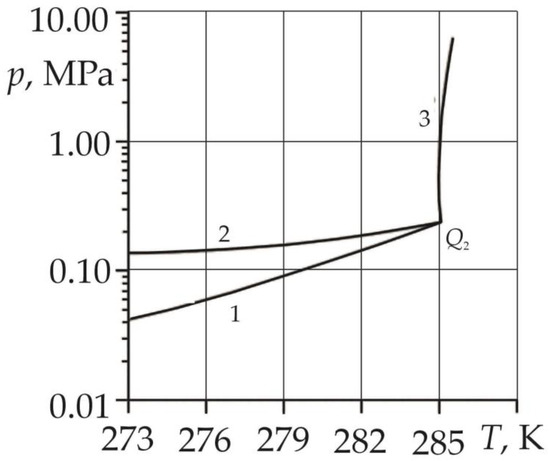
Figure 1.
Experimental phase diagram of the “SO2–H2O” system [30].
Let a porous horizontal layer of length L in the initial state be saturated with ice with initial saturation Sw0 and methane. We will assume that the initial values of temperature T0 and pressure p0 of the formation correspond to the thermodynamic conditions for the existence of sulfur dioxide (in the liquid state) and its gas hydrate (i.e., above curve 2 in Figure 1). Let liquid sulfur dioxide be injected through the left boundary of the formation (x = 0), the pressure pe and temperature Te of which correspond to the conditions for the existence of sulfur dioxide gas hydrate. We will assume that, in this case, three regions are formed in the reservoir: near, far, and intermediate. In the near zone, liquid sulfur dioxide and its gas hydrate will be present in the formation pores. The intermediate zone will be saturated with water and methane, while the far zone will be saturated with ice and methane. In this case, two boundaries of phase transitions will appear in the reservoir, separating these areas and moving deep into the reservoir. Therefore, at the near boundary of the phase transition x = x(n), SO2 gas hydrate is formed from water and sulfur dioxide, and at the far surface of the phase transition x = x(d), ice is melting.
2. Basic Equations
To describe the processes of heat and mass transfer, accompanied by the formation of sulfur dioxide hydrate and melting of ice, we will use a single-temperature model of the system under consideration with a constant value of porosity. In this case, the skeleton of a porous medium, gas hydrate, and water are incompressible and motionless; methane will be considered a calorically perfect gas, and liquid sulfur dioxide will be considered an elastic liquid. In addition, SO2 hydrate is a two-component system with a mass fraction of the hydrate-forming gas equal to G. The system of basic equations, which is the laws of conservation of mass and energy, Darcy’s law, and the equation of state under the above assumptions in each of the regions, has the form [31,32]
Here, the subscripts i = s, m refer to the parameters of liquid sulfur dioxide and methane, respectively; φ is the porosity; ρi, υi, ki, Ci, and μi are, respectively, the true density, velocity, permeability, specific heat, and dynamic viscosity of the i-phase; p is the pressure; T is the temperature; Si is the saturation of pores with the i-phase; Rg is the gas constant of methane; β is the volumetric compression ratio of liquid SO2; ρ0s is the true density of liquid sulfur dioxide corresponding to pressure p0; and ρC and λ are the specific volumetric heat capacity and thermal conductivity of the system, respectively. Since the main contribution to the values of ρC and λ is made by the corresponding parameters of the skeleton of the porous medium, we will assume them to be constant values.
The dependence of the phase permeability coefficient k(i) on saturation S(i) is set based on the Kozeny formula [33]:
where k0 is the absolute permeability of the reservoir.
The conditions for the balance of mass and heat at the near boundary of the phase transition x = x(n), which separates the near and intermediate regions and at which SO2 hydrate is formed from water and sulfur dioxide, can be represented as
Here, ρh and ρl are the densities of hydrate and water, respectively; Sh and Sl are the hydrate saturation and water saturation, respectively; Lh is the specific heat of SO2 hydrate formation; and is the velocity of the phase transition boundary. Here and below, the subscripts 1, 2, and 3 refer to the parameters of the near, intermediate, and far regions, respectively.
Similarly, the conditions at the far boundary of the phase transition x = x(d), where ice melts, can be represented as
Here, ρw0 and Lw are the density and specific heat of ice melting, respectively; and is the velocity of the far boundary of the phase transition.
The pressure and temperatures at the boundaries of phase transitions will be considered continuous quantities. In addition, since ice melts at the far boundary of phase transitions x = x(d), we assume that its temperature is T(d) = 273 K.
Since the initial ice saturation was assumed to be equal to Sw0, then from the equations of systems (2) and (3) for the values of Sl and Sh, one can obtain
The initial conditions, as well as the conditions at the outer boundaries of the reservoir, can be represented as
From system (1), the piezoconductivity equation for the near region (i = 1) can be represented as
Similar equations for the intermediate and far regions (i = 2, 3) have the form
The equation of heat influx after transformations can also be represented as
where is the formation thermal diffusivity; ; and (i = 2, 3).
To solve a closed system of Equations (5)–(7) with initial boundary conditions (4) and conditions (2)–(3) at the boundaries of the phase transition, the method of catching fronts in the nodes of a spatial grid is used [34]. In this case, a uniform spatial grid is constructed with a step h (h = L/N, N—the number of split points). It is assumed that for the unknown time step τ determined in the course of the solution from the finite-difference representation (2), the near front of the phase transition moves along the coordinate by the value h. The far boundary of the phase transition, at which ice melts, also correlates with the node of the spatial grid, for which the temperature is close to the melting temperature of ice. For each time layer, the constructed difference scheme is a system of non-linear algebraic equations. This system is solved using the Thomas algorithm and the method of simple iterations [35]. The iterative process at each time layer continued until the specified accuracy was achieved for all considered quantities: pressure, temperature, and coordinates of the fronts.
3. Analysis of the Results
In Figure 2, for time t = 10 day, the reservoir temperature and pressure distributions are presented. The injection pressure of liquid sulfur dioxide corresponds to the value pe = 3.2 MPa (fragment Figure 2a) and pe = 3.1 MPa (fragment Figure 2b). The values of other parameters used in the model are presented in Table 1. As follows from Figure 2, when SO2 is injected at a pressure of pe = 3.2 MPa, the temperature of the system rises above the melting temperature of ice. This means that in addition to the formation of sulfur dioxide hydrate and displacement of methane, the process of ice melting and, as a result, the formation of an area containing methane and water take place in the reservoir. In this case, the region 0 ≤ x < x(n) contains liquid SO2 and its hydrate in pores; the region x(n) < x <x(d) is methane and water, and the region x > x(d) contains methane and ice. At lower injection pressures (pe = 3.1 MPa), as follows from fragment b, the temperature of the system is below the melting point of ice; in this case, the formation of a region containing methane and water does not occur. Thus, at high liquid sulfur dioxide injection pressures, the formation of SO2 hydrate occurs with the formation of three different areas from water and liquid sulfur dioxide, according to the problem statement. In the case of low injection pressures, the formation of SO2 hydrate occurs from SO2 and ice without the formation of a region saturated with methane and water.
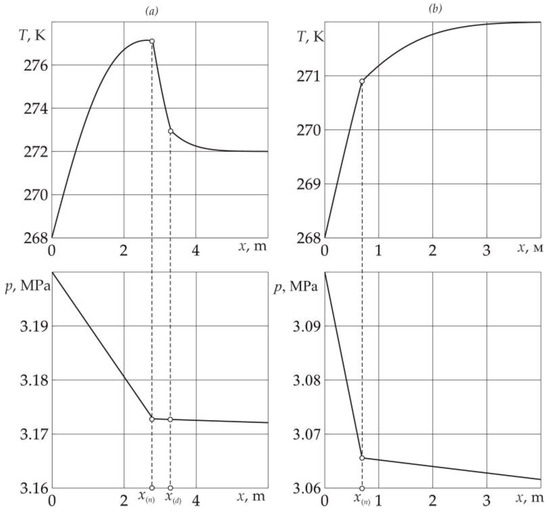
Figure 2.
Temperature and pressure distribution in the reservoir, for time t = 10 day: (a)—pe = 3.2 MPa; (b)—pe = 3.1 MPa.

Table 1.
Basic parameters for the model.
In Figure 3, for the moment of time t = 10 days, the dependences of the temperature T(n) on the near surface of the phase transition, as well as the coordinates of the near and far boundaries of the phase transition, on the injection pressure pe are presented. As follows from the figure, with a decrease in the injection pressure, both the temperature at the near boundary of the phase transition and the length of the region containing methane and water decrease. This is due to the fact that with a decrease in the value of pe, the intensity of SO2 hydrate formation decreases, which is proportional, according to Darcy’s law, to the pressure drop in the system. As a result, there is also a decrease in the magnitude of the thermal effect caused by the reaction of hydrate formation. Thus, in the case of low values of pe (less than 3.2 MPa), the intensity of hydrate formation is low, and the temperature does not rise above the melting temperature of ice. In this case, the formation of sulfur dioxide occurs from ice and SO2 without the formation of a region saturated with methane and water.
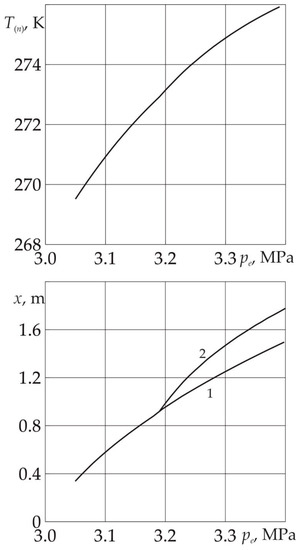
Figure 3.
Temperature dependences on the near surface, phase transition, as well as the coordinates of the near (1) and far (2) boundaries of the phase transition on the injection pressure.
Figure 4 shows the dependences of the temperature T(n) on the near surface of the phase transition, as well as the coordinates of the near and far boundaries of the phase transition, on the initial pressure of the system p0. As follows from the figure, with an increase in the initial pressure of the system, both the temperature at the near boundary of the phase transition and the length of the region containing methane and water decrease. This is explained by the fact that with increasing p0, the pressure drop in the system and, as a consequence of the Darcy law, the intensity of the phase transition decrease. Thus, the formation of sulfur dioxide hydrate from SO2 and water, according to the formulation of the problem, is possible only in the case of low values of the initial pressure. An increase in p0 values leads to a decrease in the length of the region containing methane and water, and, as a consequence, the possible formation of SO2 hydrate without its formation from sulfur dioxide and ice.
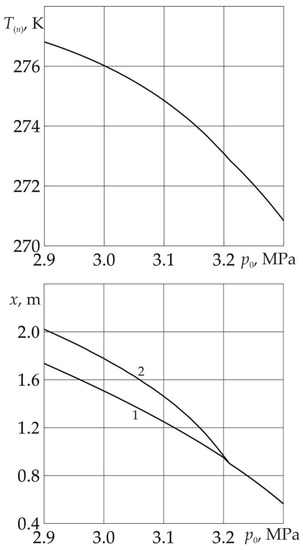
Figure 4.
Temperature dependences on the near surface, phase transition, as well as the coordinates of the near (1) and far (2) boundaries of the phase transition from the initial pressure of the system.
Figure 5 shows the dependences of the temperature T(n) on the near surface of the phase transition, as well as the coordinates of the near and far boundaries of the phase transition, on the absolute permeability k0 of the reservoir. It follows from the figure that at high values of the absolute permeability of the reservoir (greater than 10−15 m2), the formation of sulfur dioxide hydrate from SO2 and water occurs. In this case, there are three areas in the reservoir according to the formulation of the problem under consideration. With a decrease in the value of k0, the temperature at the phase transition boundary decreases. This is due to a decrease in the intensity of the phase transition, which is limited by the flow of SO2 to it and, according to Darcy’s law, is proportional to the reservoir permeability. In this case, at low values of k0, the temperature T(n) can become lower than the melting temperature of ice. In this case, the formation of SO2 hydrate occurs with the formation of two regions of SO2 and ice, without the formation of a region containing methane and water.
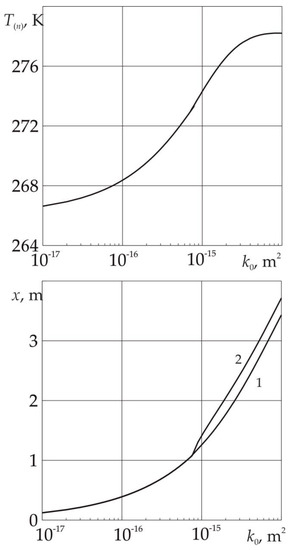
Figure 5.
Temperature dependences on the near surface, phase transition, as well as the coordinates of the near (1) and far (2) boundaries of the phase transition from the absolute permeability of the reservoir.
It should be noted that the results obtained in this work are qualitatively correlated with the theoretical calculations obtained, for example, in [30,31]. Thus, according to [31], injection of liquid carbon dioxide into a gas hydrate formation also leads to an increase in the temperature of the system; at high injection intensities, a mode with decomposition of gas hydrates is possible, and at low—without its dissociation.
Figure 6 shows the dependences of the temperature T(n) on the near surface of the phase transition, as well as the coordinates of the near and far boundaries of the phase transition, on the initial reservoir temperature T0 (fragment Figure 6a) and the injection temperature Te (fragment Figure 6b) of liquid sulfur dioxide. As follows from the figure, the temperature at the near boundary of the phase transition increases with an increase in both the initial reservoir temperature and the temperature of the injected sulfur dioxide. In this case, the coordinate of the phase transition front at which SO2 hydrate is formed (curve 1) does not depend on the values of T0 and Te, i.e., determined by the mass transfer of sulfur dioxide. In this case, the coordinate of the boundary on which ice melts (curve 2) increases with both T0 and Te, i.e., determined by heat transfer deep into the reservoir. Thus, as follows from the figure, the formation of sulfur dioxide from SO2 and water occurs at high values of the initial formation temperature and the injection temperature of liquid sulfur dioxide.
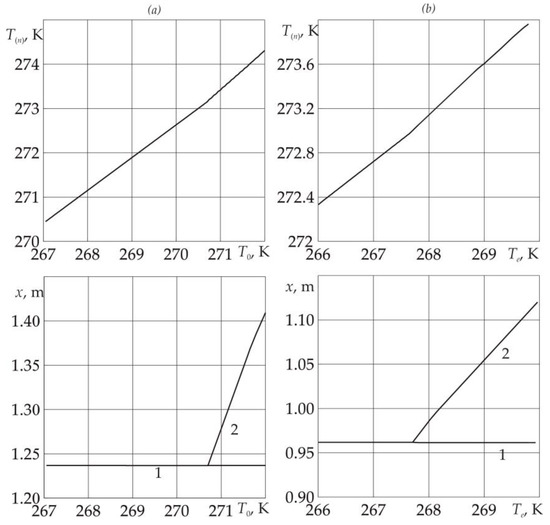
Figure 6.
Temperature dependences on the near surface, phase transition, as well as the coordinates of the near (1) and far (2) boundaries of the phase transition from the initial reservoir temperature (a) and the temperature of the injected sulfur dioxide (b).
In Figure 7, for the moment of time t = 10 days, the dependence of the critical injection temperature T*, below which the formation of SO2 hydrate occurs without the formation of a region saturated with methane and water, on the injection pressure of sulfur dioxide is presented. As follows from the figure, with an increase in the value of pe, the value of the critical temperature decreases. This is due to the fact that, in this case, the intensity of the phase transition increases; therefore, the formation of sulfur dioxide hydrate from ice and SO2 occurs at lower temperatures. In addition, as follows from the figure, the critical temperature also depends on the formation permeability. As the reservoir permeability increases, the critical injection temperature also decreases. This is explained by the fact that an increase in the value of k0 also leads to an increase in the intensity of the phase transition.
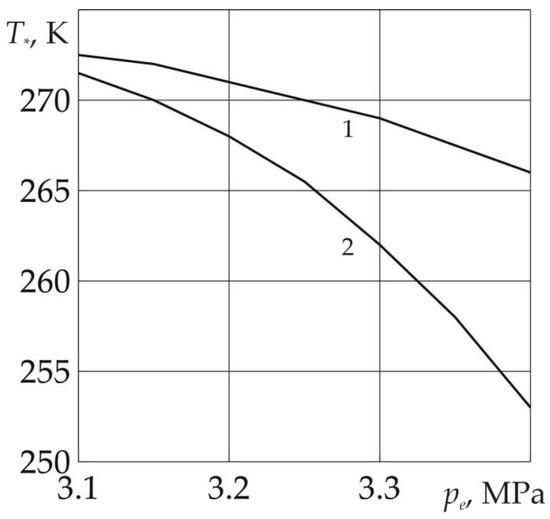
Figure 7.
Critical temperature dependences, from discharge pressure SO2 for the moment of time t = 10 days at:, 1—k0 = 5 × 10−16 m2; 2—k0 = 10−15 m2. T* denotes the critical injection temperature.
4. Conclusions
The article presents a mathematical model of the process of pumping liquid sulfur dioxide into a porous reservoir initially saturated with methane and ice. The influence of the initial system, as well as the parameters of the injected sulfur dioxide on the formation of SO2 hydrate in the formation, has been studied. It was found that at high values of the injection pressure (greater than 3.2 MPa) and the permeability of the porous reservoir (greater than 10−15 m2), SO2 hydrate is formed with the formation of a region containing methane and water. It is shown that the coordinate of the phase transition front at which SO2 hydrate is formed is determined by the mass transfer of sulfur dioxide, and the coordinate of the boundary at which the ice-melting process occurs is determined by heat transfer. It was also found that with an increase in the initial pressure of the system, the formation of sulfur dioxide hydrate occurs without the formation of a region saturated with methane and water. It is shown that the formation of sulfur dioxide from SO2 and water occurs at high values of the initial formation temperature and injection temperature of liquid sulfur dioxide. The dependence of the critical injection temperature, below which the formation of SO2 hydrate occurs without the formation of a region saturated with methane and water, on the injection pressure of sulfur dioxide is presented. It is shown that with increasing injection pressure, the value of the critical temperature decreases. The results obtained can also be used as recommendations for the possible disposal of sulfur dioxide in natural porous reservoirs containing methane and ice. Since ice is a component that cements the formation, it is relevant to choose such pumping modes of liquid sulfur dioxide, in which there is no ice-melting process. Thus, the injection of sulfur dioxide into natural formations containing methane and ice must be carried out in low-permeable reservoirs at relatively low (relative to the initial) injection pressures.
Author Contributions
Conceptualization, I.K.G. and M.V.S.; methodology, I.K.G. and M.V.S.; validation, M.V.S.; formal analysis, I.K.G.; investigation, I.K.G. and M.V.S.; writing—original draft preparation, I.K.G. and M.V.S. All authors have read and agreed to the published version of the manuscript.
Funding
This research was funded by Ministry of Education and Science. State task FEUR-2023-0006, project “Development and creation of low-tonnage products and reagents (corrosion and scale inhibitors, antioxidants, biocides, additives, etc.) for petrochemical processes and water purification from pollution, replacing imported substances and materials. Theoretical and experimental approaches.
Data Availability Statement
The data presented in this study are available on request from the corresponding author.
Conflicts of Interest
The authors declare no conflict of interest.
References
- Sloan, E.D.; Koh, C.A. Clathrate Hydrates of Natural Gases, 3rd ed.; CRC Press: Boca Raton, FL, USA, 2007. [Google Scholar] [CrossRef]
- Carroll, J. Natural Gas Hydrates: A Guide for Engineers; Gulf Professional Publishing: Houston, TX, USA, 2020. [Google Scholar] [CrossRef]
- Makogon, Y.F. Natural gas hydrates—A promising source of energy. J. Nat. Gas Sci. Eng. 2010, 2, 49–59. [Google Scholar] [CrossRef]
- Yong, H.; Peng, X.; Ye, Y. Development in technology of prospecting and extraction for gas hydrates. Geol. Prospect. 2002, 38, 70–73. [Google Scholar]
- Wu, C.; Zhao, K. Current research in natural gas hydrate production. Geol. Sci. Technol. Inf. 2008, 27, 47–52. [Google Scholar]
- Ahmadi, G.; Ji, C.; Smith, D.H. Numerical solution for natural gas production from methane hydrate dissociation. J. Pet. Sci. Eng. 2004, 41, 269–285. [Google Scholar] [CrossRef]
- Ahmadi, G.; Ji, C.; Smith, D.H. Production of natural gas from methane hydrate by a constant downhole pressure well. Energy Convers. Manag. 2007, 48, 2053–2068. [Google Scholar] [CrossRef]
- Tsypkin, G.G. Effect of decomposition of a gas hydrate on the gas recovery from a reservoir containing hydrate and gas in the free state. Fluid Dyn. 2005, 40, 117–125. [Google Scholar] [CrossRef]
- Vasil’ev, V.I.; Popov, V.V.; Tsypkin, G.G. Numerical investigation of the decomposition of gas hydrates coexisting with gas in natural reservoirs. Fluid Dyn. 2006, 41, 599–605. [Google Scholar] [CrossRef]
- Tsypkin, G.G. Analytical solution of the nonlinear problem of gas hydrate dissociation in a formation. Fluid Dyn. 2007, 42, 798–806. [Google Scholar] [CrossRef]
- Tsypkin, G.G. Flows with Phase Transitions in Porous Media; Fizmatlit: Moscow, Russia, 2009. [Google Scholar]
- Gerami, S.; Pooladi-Darvish, M. Predicting gas generation by depressurization of gas hydrates where the sharp-interface assumption is not valid. J. Pet. Sci. Eng. 2007, 56, 146–164. [Google Scholar] [CrossRef]
- Musakaev, N.G.; Khasanov, M.K. Solution of the Problem of Natural Gas Storages Creating in Gas Hydrate State in Porous Reservoirs. Mathematics 2020, 8, 36. [Google Scholar] [CrossRef]
- Musakaev, N.G.; Borodin, S.L.; Gubaidullin, A.A. Methodology for the Numerical Study of the Methane Hydrate Formation During Gas Injection into a Porous Medium. Lobachevskii J. Math. 2020, 41, 1272–1277. [Google Scholar] [CrossRef]
- Borodin, S.L.; Musakaev, N.G.; Belskikh, D.S. Mathematical Modeling of a Non-Isothermal Flow in a Porous Medium Considering Gas Hydrate Decomposition: A Review. Mathematics 2022, 10, 4674. [Google Scholar] [CrossRef]
- Shitz, E.Y.; Koryakina, V.V.; Ivanova, I.K.; Semenov, M.E. Research on growth kinetics and growth mechanism of natural gas hydrates in water-in-asphaltene-resin-paraffin deposits (ARPD) and water-in-oil emulsions. Chem. Sustain. Dev. 2018, 26, 271–280. [Google Scholar] [CrossRef]
- Ivantsova, A.O.; Lyubimova, T.P.; Lyubimov, D.V. Dynamics of vertical channel penetrating hydrate layer. Bull. Perm Univ. Ser. Phys. 2012, 4, 65–68. [Google Scholar]
- Zhao, J.; Xu, K.; Song, Y.; Liu, W.; Lam, W.; Liu, Y.; Xue, K.; Zhu, Y.; Yu, X.; Li, Q. A Review on Research on Replacement of CH4 in Natural Gas Hydrates by Use of CO2. Energies 2012, 5, 399–419. [Google Scholar] [CrossRef]
- Voronov, V.P.; Gorodetskii, E.E.; Muratov, A.R. Experimental study of methane replacement in gas hydrate by carbon dioxide. J. Phys. Chem. B 2010, 114, 12314–12318. [Google Scholar] [CrossRef]
- Nago, A.; Nieto, A. Natural gas production from methane hydrate deposits using CO2 clathrate sequestration: Stateof-the-art review and new technical approaches. J. Geol. Res. 2011, 2011, 239397. [Google Scholar] [CrossRef]
- Parshall, J. Production Method for Methane Hydrate Sees Scientific Success. J. Pet. Technol. 2012, 64, 50–51. [Google Scholar] [CrossRef]
- Lackner, K.S. A Guide to CO2 Sequestration. Science 2003, 300, 1677–1678. [Google Scholar] [CrossRef]
- Kang, Q.; Lichtner, P.; Viswanathan, H.S.; Abdel-Fattah, A.I. Pore Scale Modeling of Reactive Transport Involved in Geologic CO2 Sequestration. Transp. Porous Media 2010, 82, 197–213. [Google Scholar] [CrossRef]
- Benson, S.M.; Cole, D.R. CO2 Sequestration in Deep Sedimentary Formations. Elements 2008, 4, 325–331. [Google Scholar] [CrossRef]
- Anshits, A.; Kirik, N.; Shibistov, B. Possibilities of SO2 storage in geological strata of permafrost terrain. Adv. Geol. Storage Carbon Dioxide 2006, 65, 93–102. [Google Scholar] [CrossRef]
- Li, Q.; Li, X.; Wei, N.; Fang, Z. Possibilities and potentials of geological co-storage CO2 and SO2 in China. Energy Procedia 2011, 4, 6015–6020. [Google Scholar] [CrossRef]
- Kvamme, B.; Graue, A.; Buanes, T.; Kuznetsova, T.; Ersland, G. Storage of CO2 in natural gas hydrate reservoirs and the effect of hydrate as an extra sealing in cold aquifers. Int. J. Greenh. Gas Control 2007, 1, 236–246. [Google Scholar] [CrossRef]
- White, M.D.; McGrail, P.B. Designing a pilot-scale experiment for the production of natural gas hydrates and sequestration of CO2 in class 1 hydrate accumulations. Energy Procedia 2009, 1, 3099–3106. [Google Scholar] [CrossRef]
- Garapati, N.; Velaga, S.C.; Anderson, B.J. Development of a thermodynamic framework for the simulation of mixed gas hydrates: Formation, dissociation, and CO2-CH4 exchange. In Proceedings of the 7 International Conference on Gas Hydrates, Edinburg, UK, 17–21 July 2011. [Google Scholar]
- Istomin, V.A.; Yakushev, V.S. Gas Hydrates in Nature; Nedra: Moscow, Russia, 1992. [Google Scholar]
- Khasanov, M.K.; Stolpovsky, M.V.; Gimaltdinov, I.K. Mathematical model for carbon dioxide injection into porous medium saturated with methane and gas hydrate. Int. J. Heat Mass Transf. 2018, 127, 21–28. [Google Scholar] [CrossRef]
- Khasanov, M.K.; Stolpovsky, M.V.; Gimaltdinov, I.K. Mathematical model of injection of liquid carbon dioxide in a reservoir saturated with methane and its hydrate. Int. J. Heat Mass Transf. 2019, 132, 529–538. [Google Scholar] [CrossRef]
- Barenblatt, G.I.; Entov, V.M.; Ryzhik, V.M. Movement of Liquids and Gases in Natural Formations; Nedra: Moscow, Russia, 1982. [Google Scholar]
- Samarskij, A.A.; Vabishchevich, P.N. Computational Heat Transfer; Editorial URSS: Moscow, Russia, 2003. [Google Scholar]
- Samarskij, A.A.; Gulin, A.V. Numerical Methods; Nauka: Moscow, Russia, 1989. [Google Scholar]
Disclaimer/Publisher’s Note: The statements, opinions and data contained in all publications are solely those of the individual author(s) and contributor(s) and not of MDPI and/or the editor(s). MDPI and/or the editor(s) disclaim responsibility for any injury to people or property resulting from any ideas, methods, instructions or products referred to in the content. |
© 2023 by the authors. Licensee MDPI, Basel, Switzerland. This article is an open access article distributed under the terms and conditions of the Creative Commons Attribution (CC BY) license (https://creativecommons.org/licenses/by/4.0/).